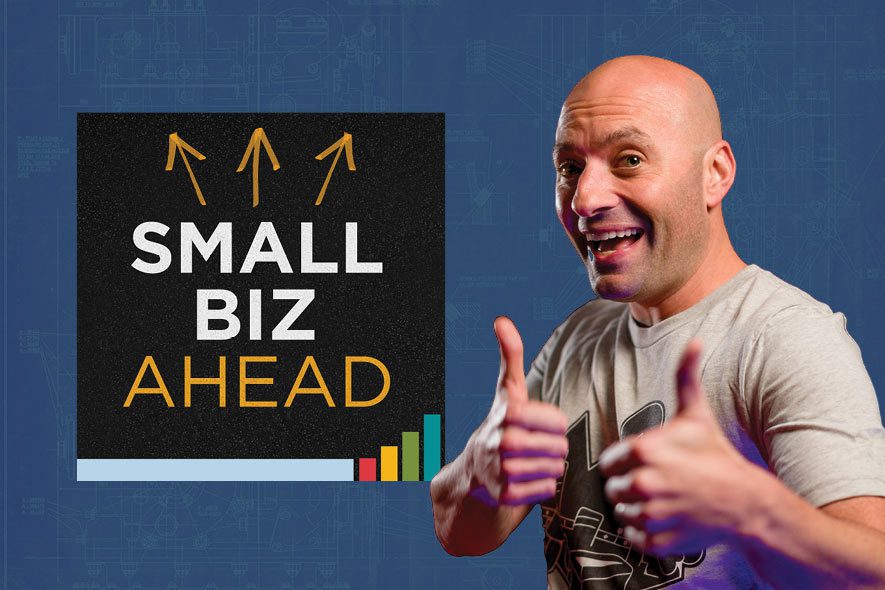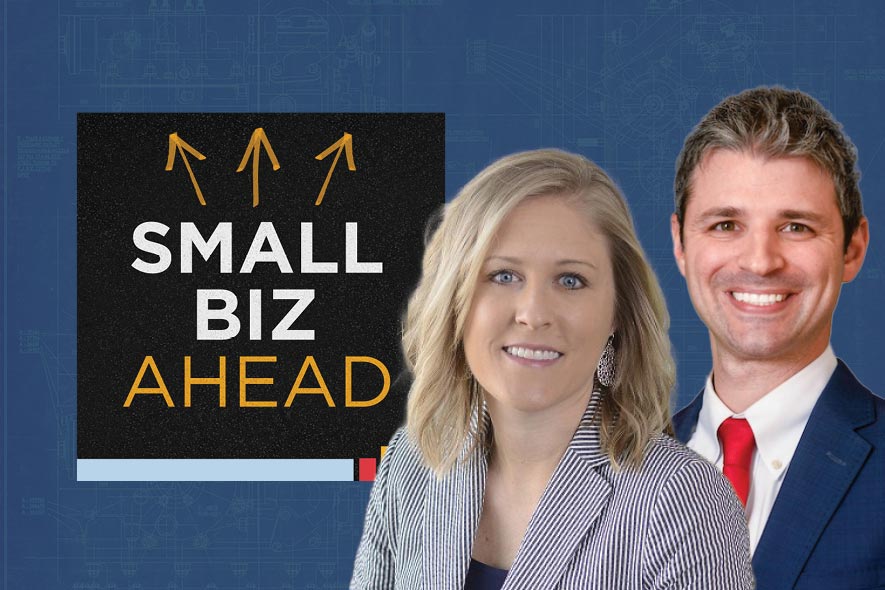Are you interested in setting up a profit sharing plan for your small business? While a profit sharing plan might seem like the ideal employee benefit, business owners need to be aware of both the commitment and transparency involved once they implement one.
In episode #88, Elizabeth Larkin and Gene Marks guide you through the process of creating the most effective profit sharing plan for your business.
Executive Summary
0:22—Today’s Topic: How Do I Create a Profit Sharing Plan that Fits My Business?
0:46—If you’re not comfortable disclosing your company’s profits to your employees, you might consider offering bonuses or raises instead.
3:12—Yearly bonuses are suitable for any business, but once you start giving them to your employees, you have to continue.
5:34—The most popular bonus plans among small businesses are those that are tied to a 401-k plan .
7:46—Profit sharing plans are suitable only if you are comfortable disclosing your company’s financial performance and are willing to enter a contractual agreement that requires you to set aside a certain percentage of those profits for your employees.
9:53—You will need to consult with either an accountant or an attorney to figure out the specific details of your profit sharing plan.
15:05—Gene emphasizes the importance of adjusting the services and inventory of your company to fit its changing demographics.
Links
Download Our Free eBooks
- Ultimate Guide to Business Credit Cards: The Small Business Owner’s Handbook
- How to Keep Customers Coming Back for More—Customer Retention Strategies
- How to Safeguard Your Small Business From Data Breaches
- 21 Days to Be a More Productive Small Business Owner
- Opportunity Knocks: How to Find—and Pursue—a Business Idea That’s Right for You
- 99 New Small Business Ideas
Submit Your Question
Transcript
Elizabeth: Okay, Gene, last episode we teased our listeners with talking about profit-sharing plans.
Gene: Right.
Elizabeth: First, I want to talk about what you do at your business, and then I want to walk through the different options that small business owners … because I think it feels like for a small business owner, especially if you’re just starting out, you’re like, a profit … I’m going month to month here. Let’s talk about what you do.
Gene: So what I do, and we’ll talk about what a lot of my clients do, I don’t have a profit-sharing plan, period.
Elizabeth: But you give out bonuses.
Gene: I give out bonuses, but there’s a difference between giving out bonuses and making it a profit-sharing plan. In a profit-sharing plan, people know your profits. I don’t want people to know my profits. I don’t want my employees to know what our revenues are and what our profits … and by the way, that’s a debatable topic, because I have clients that have the same point of view, but then as they get older and they want to have a more formalized profit-sharing plan, which we’ll talk about, that’s driven by net profits, well, you’ve got to share that information with your employees. I don’t want to share that information.
Elizabeth: How do you decide bonuses, then? Do you have that built into people’s contracts, like you’re gonna get 10% of your-
Gene: No. It’s all discretionary. Every year, at the end of the year, I generally give a week’s salary as bonus, is what it is. The thing that you have to remember about that is once you do it, you really can’t go back. I can’t give you a week’s bonus in 2016, and then in 2017 be like, oh sorry, Liz, but I’m not in the mood to do that, because you can’t take it away.
Elizabeth: Well, then why don’t you do it as a percentage of your profits?
Gene: Because I don’t want people to know what my profits are.
Elizabeth: Why do you have to tell them?
Gene: Because then they’re gonna question. It complicates the conversation. If I say to them, look, I’m gonna give you a percentage of my profits, and then one year it’s higher, one year it’s lower, it’s sharing too much information with everybody. To me, you get a week’s salary, and that’s what it is. And by the way, I also add on some added vacation time as well. I do that, too. But it’s discretionary, discretionary, discretionary.
Elizabeth: Do you give raises every year?
Gene: We do, and the raises are generally raises between 2% to 3% every year. The average salary increase for 2017, this is according to like paychecks, the big payroll companies, about 2.7%. We’re looking to see the same in 2018.
Elizabeth: Every year you are giving a little more. You’re giving a raise and then you’re also giving a week’s salary.
Gene: Yeah. But a raise is not a profit-sharing. And a raise is expected. People expect to get their raises. That’s just what it is. There was two years where we didn’t give raises and it was right during the recession, where we really held tight. But then we started giving them again. You gotta do it to be competitive. If you work for me, you get your salary, there is a raise based on your performance review, which that’s another topic to talk about, but then, all things being good, you can expect to get a week’s salary as your bonus.
Elizabeth: Before we dive into profit-sharing plans, does it make sense for all businesses to give bonuses or do you think some businesses should never do that?
Gene: Well, I don’t want to say some businesses shouldn’t. Once you start doing it, people are gonna expect it.
Elizabeth: Because I’ve worked at small businesses where I never got a bonus.
Gene: You never got a bonus, so you never expected one and that was just the way it was. If you’re not giving bonuses to your employees, there’s no reason to start doing it-
Elizabeth: So why do you do it?
Gene: Well, I just always thought it was a good thing to do. I kinda grew up on that. I always got bonuses when I worked in corporate America, so I was just used to it.
Elizabeth: Do you think it retains, it helps with employer retention?
Gene: No. I think at this point, everybody just expects it, like an extra paycheck. If I didn’t give a bonus, it would hurt me. Sometimes I do think that to myself, I don’t know why I even started doing this. Because now it’s like I have to do it, and if I don’t do it-
Elizabeth: When did you-
Gene: A few years into the business.
Elizabeth: What time of year do you give them out?
Gene: At Christmas time, around the end of the year usually.
Elizabeth: So like December?
Gene: What I do with the bonus as well, and I still do this … we were talking in a previous podcast about handwritten notes. We have a special payroll run with the week’s salary. There’s only ten people in my company, for God’s sake, so I always make it a thing where I take the check itself, it’s a physically signed check I do, and I slip it in with a holiday card-
Elizabeth: And you write like, thanks, Gene on it?
Gene: Yeah, I do. I write a little nice message, give me some credit. And I mail it to the person. One of my employees told me, years ago, they didn’t even know they got the bonus from me because it was in a stack of Christmas cards they had gotten. They fell behind and they were away. They didn’t open it till January. I was like, jeez. But everybody expects one. When they get the holiday card from Gene, trust me, it’s the first card they open when they get it. That’s what we do.
If you’re running a business, there’s no requirements to do it. Just remember, if you’re going to give bonuses, once you start, you cannot go back. People expect what they got last year, they will expect it again this year.
Number two is, if you want to make is discretionary, that’s what I do, that does give you the most flexibility, so you’re not tied into any contractual agreement of giving people bonuses. Most of my clients that are less than 50 employees, if they do give bonuses, it’s a discretionary bonus.
We talk about different bonus plans that there are. The most popular thing that I’ve seen my clients do, and again, this is 2017, is they tie it to people’s 401(k) plans. We don’t have a 401(k) plan in our business, and I’m gonna institute one this year. It’s crazy. I just have a retirement plan for myself, like an IRA.
Elizabeth: Then your employees are just on their own?
Gene: They’re on their own. It’s so stupid. It’s less than a thousand bucks to get it set up and I am gonna do it this year. I’m gonna make a change. I’ve learned from other clients. If you have a 401(k) plan, nobody’s required to contribute to it if they don’t want to, but, of course, they’re encouraged to do it. They put money away for retirement, that’s good. But as an employer, you can use the 401(k) plan for the bonus. In other words, you have a 401(k) account, if you at least enroll in the 401(k) plan, you don’t have to contribute anything to it, when you get your bonus at the end of the year, I’m gonna put it into their 401(k) plan is what I’m gonna do. Again, it’s still discretionary, but I’m gonna give it to them that way. That way it’s kind of forcing them to put money away for their retirement. It’s still money, it’s still there, and you can always cash it out if you want to. I have a lot of clients that do the same thing, like they don’t give checks for bonuses anymore.
Elizabeth: So it’s only $1,000 to set up a 401(k)?
Gene: Yeah, it’s very inexpensive to set it up. It could be even less. If you go to some banks, Capital One has this whole thing, that’s who I’m gonna do it with I think, they’ve got a whole division that does it. All the banks have divisions for small businesses. If you talk to your bank, again, I looked at a bunch of them and I liked the Capital One.
Elizabeth: You do have to be careful though and make sure that you’re not locked into a bunch of mutual funds that charge huge rates.
Gene: It’s a whole other conversation about 401(k) plans, but you’re right. Because some of them are, you’ve got a fiduciary duty over that money. You’ve gotta make sure you’re giving people choices. You’ve gotta file tax returns for the 401(k). There’s stuff you gotta do. It’s all cookie-cutter nowadays.
Elizabeth: Let’s do another episode on 401(k) plans.
Gene: It’s a good conversation to have. But getting back to bonuses, again, if you’re running a business, you’re like “You know what, I’m gonna start doing bonuses, or maybe I’m already doing bonuses,” I’ve just seen a large trend of clients, they put the bonuses into a 401(k) plan.
Elizabeth: Let’s talk about a profit-sharing plan.
Gene: We don’t have a profit-sharing plan. I do have clients that do. I do have a lot of readers that write to me about their own profit-sharing plans. Profit-sharing plans I generally see that with larger than smaller businesses. Rule of thumb, more than 50 people is where-
Elizabeth: That’s still considered a small business.
Gene: It’s still considered, but it’s a little bit larger than a mom and pop type of thing. Although it could be mom and pop with 50. I’m just giving you a rule of thumb that when you start getting to that size, I see people gravitate towards a profit-sharing plan. I don’t like it for my business, and again this is a debate to have elsewhere, but if you’re gonna have a profit-sharing plan, you have to disclose your profits. That means that it’s a contractual plan, and you’re gonna be taking a certain percentage of your profits and putting it away in the form of bonuses to people. Therefore, people are gonna have to know what your profits are so that they know that their being allocated what they deserve.
Elizabeth: Is there a business that that’s better for? Let’s say you have a big sales force-
Gene: It’s a culture. It’s a culture. It’s a culture. It’s a business where … I have a client outside of Philadelphia, it’s guy that runs a roofing company. He’s got about 60 employees. He tries to run his company like a big business, for better or for worse. He’s done well. But he shares the company’s financial performance with all of his employees, from salespeople to the admin. They all know how the company’s doing, profitable or not, because he believes … his attitude is we’re all in this together. The more profits that we make, the more you get as your bonus at the end of the year.
Elizabeth: I kinda like that as an employee.
Gene: Sure, I hear you. And you know, his employees like it, too. So there’s a strong argument to be made for having that attitude, but there are a lot of business owners, like me, that say, “You know what? I just don’t want to share. It’s too personal for me to share in my little business.” That’s the debate. It’s a debate to have. If you want to tie it into your profits, just know you’re gonna have to disclose the profits.
Elizabeth: How would you get this started? Do you go to your banker? Your accountant?
Gene: You do. It’s not really your banker. Your accountant is a really great place to start. Or an attorney that’s specializes in employee benefits. You create a formalized contract for your profit-sharing plan-
Elizabeth: With your accountant?
Gene: With your accountant. Remember, whatever bonuses you’re paying are tax-deductible and what not. But these types of plans themselves, you devise them in all different ways. For example, how do you distribute the profit? Say your company makes 10% profit and you made $100 in profit this year. Who gets it? Does everybody get an equal amount? I don’t know. Don’t your managers, the uppity-ups deserve more than the lower classes. I don’t know.
Elizabeth: No, the people that are actually doing the work.
Gene: Doing the work, yeah. These are all issues that come up as to how it’s then allocated once you determine what those profits are.
Elizabeth: Most large companies have a set percentage of your salary that you can expect to get every year in your bonus. So if the bonus pool is fully funded, you’re getting that percentage. If it’s not, you’re not gonna get that percentage. But it is discretionary.
Gene: Right. We like to hear what big companies do. Small businesses are into that. So that’s interesting, that you would do that. Again, that also presents a math problem, by the way, figuring all of that out. It’s complicated.
Elizabeth: It is complicated.
Gene: And a lot of small businesses, like mine, don’t have the time to figure all that out.
Elizabeth: That’s where you can maybe lean on your accountant a little bit, to make it as simple as possible. But you’re also rewarding people.
Gene: Correct. What I’ve found with some clients is … First of all, everybody creates pools. It’s 10% but we have $100 in profits, $10 of it is gonna go to profit sharing. Then what happens is, I have companies that-
Elizabeth: Wait, back up a minute. So you have profits-
Gene: And then you say your profit sharing plan says we will put 10% or 5% or 15%-
Elizabeth: And that’s what you’re working out with your accountant?
Gene: That’s correct, what you think is the right number that you’re gonna be giving away. Then, as far as allocating it to your employees, you then create pools. So you say, I’ve got our manager of the warehouse, and I’ve got the manager of the customers, so the office manager of customer service, and I’ve got the sales manager. I’ve got those three people that work in this business. We’re an established business, right? We’re gonna give each of them a third of the profit sharing, and then we’ll leave it up to them to distribute among their people. They can play God. I have clients that do that. “Listen, you’re the manager, so you know your good people. You determine how you’re gonna give it out.” Some people like to get a little more complicated and say at certain levels they should be at least getting a certain amount. But you want to give your people flexibility.
Elizabeth: Now if your profits are down, no bonus pool.
Gene: Yeah, that’s true. Again, that’s where you get into trouble when you’re sharing numbers, because when your profits are down … this is what I’ve seen with clients. First of all, people will question why I’m not getting a bonus this year. “Well, our profits are down.” “Oh, really?” “Yeah, it wasn’t my fault, or my group is doing well, or I had a great year.” You get people pointing fingers at each other and getting into fights and all that. That’s why I don’t even want to deal. That’s why I just give a week’s salary. Some years it’s good and some years it’s, nah, it’s been good. That’s generally what we’ve done to share profits.
By the way, I know you were gonna ask another question, but I just want to say, this probably doesn’t apply to many people listening to this podcast, but a lot of technology companies, startups, venture capital funded companies-
Elizabeth: We have those listeners.
Gene: Okay, but I’m just saying I don’t know if that’s the majority of people because we’re talking about established businesses here. Companies like that, that are looking to go public, a lot of them have stock option plans and restricted stock plans where you’re giving away equity in your company as part of your profits. A lot of times, it’s not making profits, but you give away equities, you give away stock options where you can buy into stock. That’s a whole other conversation to have and that’s a whole separate plan, non-qualified or qualified stock option plans that you can offer to your employees. Most of my clients, and I’m gonna bet most of the people listening to this podcast, I don’t want to say-
Elizabeth: Presume.
Gene: … presume, but most of my clients are not gonna go public. They’re not venture-funded and they don’t have that kind of structure.
Elizabeth: If people have more questions about profit sharing plans-
Gene: Reach out.
Elizabeth: … please comment in the comments. I’m actually gonna make, not make Gene, but I’m gonna strongly encourage Gene to reply-
Gene: I will, I will.
Elizabeth: … to any of those comments.
Gene: Oh, I’ll reply.
Elizabeth: I was so excited because a couple months ago we did a podcast about content marketing, and they said anyone that comments on this, tell me about your business, I’ll give you some content marketing ideas. And someone did. We’re gonna talk about that in an upcoming podcast.
But we’re gonna be right back with Gene’s Word of Brilliance.
Our Sponsor
This podcast is brought to you by The Hartford. When the unexpected strikes, The Hartford strikes back for over 1 million small business customers with property, liability and worker’s compensation insurance, check out The Hartford’s small business insurance at TheHartford.com.
WORD OF BRILLIANCE: Silver Tsunami
Elizabeth: And we’re back with Gene’s Word of Brilliance.
Gene: The word of brilliance today, I know it’s two words, Elizabeth, so don’t yell at me. We need to change it to the phrase of brilliance, I think. The words-
Elizabeth: Just brilliance, brilliance.
Gene: Just brilliance. Silver Tsunami.
Elizabeth: I think we’ve talked about this before.
Gene: In one respect, we did, but not in this respect. You have a very good memory. The silver tsunami refers to the aging workforce. That’s what we talked about before. Where all these older people were getting older, and people that owned businesses were getting out of the businesses, and there was concern as to whether or not they would have a succession plan, and it could put a lot of people out of work, right?
Well, there’s another silver tsunami going on, which actually is a good thing. If you’re a merchant, or you are selling to consumers, this is important for you to know. Big stores, department stores like Kohl’s and Macy’s and Target are looking at their demographics, and they are realizing that a lot of shoppers that are coming into their stores are older than they were before, and they’ve got extra cash because they’re baby boomers. They’ve done okay. They have changed. They are changing some of the things they’re doing. For example, Boscov’s, which is a department store in the mid-Atlantic, I don’t know if you guys have them.
Elizabeth: I’ve never heard of that.
Gene: They’re all up and down the east coast. They started a hearing aid division to cater to their customers. The Best Buy is now doing those systems, “I’ve fallen and I can’t get up” systems, the communication systems. They’re having their Geek Squad install it for their customers ’cause they’re realizing that there is a need.
My advice to you is that if you’re a merchant or you’re a store, a lot of other stores are looking at the customers coming and they’re adjusting their shelves, they’re putting in big signs for help to assist, they’re widening aisles to allow people with canes and wheelchairs to walk around. It’s a changing demographic.
Elizabeth: I have noticed this, because they just redid the Nordstrom in Westfarms Mall in Hartford, Connecticut, and they made the section for teens and early 20s a lot bigger, what I would call the junior section. Gene’s like, I have no idea about women’s attire.
Gene: No, I don’t go there.
Elizabeth: Then they made the section for what I would call 50 plus a lot bigger. The area where I shop, the 30 something area-
Gene: Inbetweeners, yep.
Elizabeth: The Gen-Xers, I guess, is a lot smaller now.
Gene: Isn’t that funny? Because they’ve realized they’re looking at their demographics and they’re saying, those teens, that’s a demographic there. But then the 50 plus generation is the same thing.
So when you’re restocking your store, depending on what you’re selling, even if you’re a coffee shop, if you’re restaurant, think what do your older people like to eat or drink-
Elizabeth: Or how do they like to be served?
Gene: How do they like to be served. You and I have always talked about, for example, the mobile payments, making sure you … okay, listen, depending on your location, if your clientele is an older clientele, maybe they’re not so crazy about mobile, maybe they’d like to do it the old way.
Elizabeth: They just want to use their credit card.
Gene: That’s right. I guess I’ll just say that the point of the whole silver tsunami that’s happening and continuing to be happening is that big stores are recognizing this and making changes to what they’re offering and how they’re designed. If you’re running a small business, you should be doing the same.
Elizabeth: Good advice. We’ll be back in a couple days. Our next episode is about how to survive a natural disaster-
Gene: Ooh.
Elizabeth: … as a small business owner, which is not something that we really want to have to talk about. But obviously, we do.





